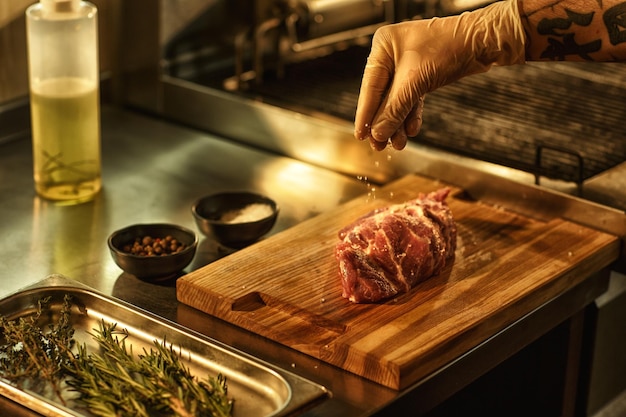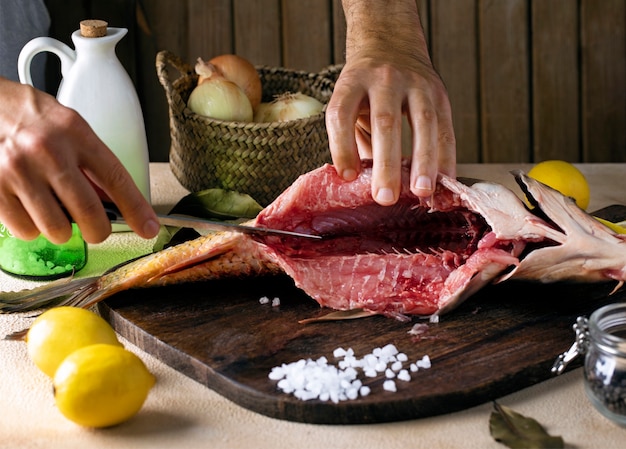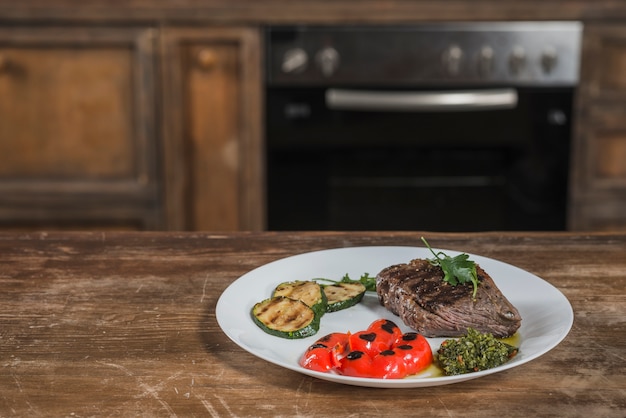Let's face it, a perfectly cooked ribeye steak is a culinary masterpiece. It’s the kind of dish that makes you feel like a master chef, and it's a surefire way to impress your guests. But achieving that juicy, tender, and perfectly seared steak can feel like a daunting task. Fear not, my friend! This guide is your roadmap to oven-baked ribeye perfection, packed with tips, tricks, and personal anecdotes from my own journey as a steak enthusiast. Get ready to elevate your steak game from "meh" to "magnificent!"
(Part 1) choosing the right ribeye: A Cut Above the Rest

The Anatomy of a perfect ribeye
Think of choosing a ribeye like selecting a fine wine: it's about finding the right balance of qualities. The first thing you want to look for is marbling. Those beautiful streaks of white fat running through the meat are key. They not only add flavor but also keep the steak juicy and tender. Imagine a ribeye like a marbled cake – more marbling means more flavour and moisture!
The next factor is thickness. This is where personal preference comes into play. I typically go for a 1.5-inch thick ribeye. It strikes a nice balance between a substantial steak and a manageable cooking time. But if you're feeling bold, a thicker cut, maybe even 2 inches, can be truly rewarding. Just remember, a thicker steak needs a longer cooking time.
Butcher's Intuition: Your Secret Weapon
Honestly, the best way to get a truly exceptional ribeye is to seek out a skilled butcher. They're the experts, and they'll guide you toward the most flavorful cuts. Don't be shy about asking questions! Talk to them about your desired thickness, how many people you're serving, and any special requests you have. You'll get valuable insight and maybe even some insider tips.
(Part 2) Prepping for Perfection: Setting the Stage for a Stellar Steak

Room Temperature Ritual: The Key to Even Cooking
Now, this is a crucial step that many people overlook, but it makes a HUGE difference. You want your steak to be at room temperature before you start cooking. Think of it like warming up your car engine before hitting the road. When you cook a cold steak, the outside cooks faster than the inside, leading to an unevenly cooked steak. By bringing the steak to room temperature, you ensure even cooking, resulting in a juicy, tender masterpiece. It’s worth the extra 30-45 minutes of patience!
Seasoning Secrets: Simple is Sophisticated
While you might be tempted by fancy spice blends, remember, sometimes the simplest things are the most effective. Salt and freshly ground black pepper are all you really need for a ribeye to sing. I like to use coarse sea salt, which creates a beautiful, crunchy crust. Be generous with the seasoning, but don't overdo it. You want to taste the steak, not just the salt. And remember, salt brings out the steak's natural flavors, enhancing the richness.
Oil Up for Success: Choosing the Right Lubricant
The right oil is like a good lubricant for your steak. It helps create a beautiful sear and keeps the steak moist while it cooks. I'm a loyal fan of extra virgin olive oil, but avocado oil or grapeseed oil are great alternatives. Look for oils with a high smoke point, meaning they won't burn before the steak is cooked. Liberally coat the steak with your chosen oil, ensuring every surface, including the sides, is well-coated.
(Part 3) Mastering the Oven Bake: A Symphony of Heat and Patience

Preheating Perfection: Setting the Stage for a Delicious Performance
Get that oven cranked up to 400°F (200°C)! A hot oven is essential for achieving that perfect sear and developing a delicious crust. Imagine the oven as a stage, and your steak is the star of the show – you need to set the right temperature for a dazzling performance.
The Baking Dish: Choosing the Right Stage
Now, choose a baking dish that's large enough to accommodate your steak comfortably. I'm a sucker for cast iron skillets because they retain heat well, giving the steak an incredible crust. However, a regular baking dish will work just fine.
Steak on Stage: Bringing the Heat
With your oven preheated and steak prepped, it’s time to take center stage. Place your seasoned ribeye into the hot oven and bake for 10-15 minutes, or until it reaches your desired doneness. Now, how do you know when that perfect moment arrives? This is where the art of steak cooking meets a bit of science.
steak doneness chart: Your Guide to steak perfection
| Doneness | internal temperature (°F) | Internal Temperature (°C) |
|---|---|---|
| Rare | 125-130 | 52-54 |
| Medium Rare | 130-135 | 54-57 |
| Medium | 135-140 | 57-60 |
| Medium Well | 140-145 | 60-63 |
| Well Done | 145-150 | 63-65 |
meat thermometer: Your Steak's Personal Trainer
For the ultimate level of control and confidence, invest in a good meat thermometer. It's a small investment that can make a huge difference in the quality of your steak. Stick the thermometer into the thickest part of the steak, making sure it doesn't touch any bone. This way, you can be absolutely certain that your steak is cooked to your liking, every time.
(Part 4) The Rest is Golden: Allowing Your Steak to Shine
Rest Up, Steak: A Moment of Relaxation for Maximum Flavor
Once your steak has reached its desired doneness, don't rush to cut into it. Give it a good 10 minutes to rest. This allows the juices to redistribute throughout the steak, resulting in a more tender and flavorful bite. Think of it as a little spa treatment for your steak. While it’s resting, you can focus on prepping your sides – mashed potatoes, asparagus, roasted vegetables – whatever your heart desires!
(Part 5) The Finishing Touch: Adding a Touch of Magic
Butter, Garlic, and Rosemary: A Culinary Symphony
This is where your steak gets elevated to an entirely new level of deliciousness. While your steak is resting, melt some butter in a small pan over medium heat. Add a few cloves of garlic, a sprig of rosemary, and a pinch of salt and pepper. Let the garlic and rosemary infuse the butter for a few minutes. Then, pour the buttery goodness over the rested steak. This final touch adds a burst of aromatic flavor and creates a beautiful, glistening finish.
(Part 6) Time to Feast: The Grand Finale
Slicing and Serving: A Culinary Performance
Slice the steak against the grain, meaning cut across the muscle fibers. This helps tenderize the meat and makes it easier to chew. Serve the steak immediately, alongside your chosen sides.
Wine Pairing: Completing the Symphony
And of course, no steak dinner is complete without a glass of wine! A full-bodied red wine, like Cabernet Sauvignon or Merlot, is a perfect companion for a ribeye steak. Enjoy!
(Part 7) Alternative Cooking Methods: Expanding Your Culinary Horizons
The reverse sear: A Slow and Steady Approach to Perfection
If you're looking for a more foolproof method, try the reverse sear. This involves cooking the steak in a low oven for a longer period, then searing it on the stovetop for a crispy crust. Here's the breakdown:
1. Low and Slow: Preheat your oven to 250°F (120°C) and bake the steak for 1-1.5 hours, or until it reaches an internal temperature of 125°F (52°C) for rare. This slow cooking process ensures even cooking and prevents the steak from drying out.
2. Sealing the Deal: Remove the steak from the oven and sear it on a hot skillet for 2-3 minutes per side. This creates that coveted crust and seals in the juices.
The Grill: The Classic Approach to Steak Perfection
No steak lover can forget the joy of grilling. It's a classic method that imbues the steak with a smoky flavor that's hard to beat. Here's how to master the grill:
1. Get Hot: Preheat your grill to medium-high heat.
2. Grill Time: Grill the steak for 4-5 minutes per side for medium-rare. You can adjust the grilling time based on your desired doneness.
(Part 8) Troubleshooting and Tips: Conquering Steak Challenges
Steak Gone Wrong? No Problem!
Let's face it, sometimes even the best-laid plans can go awry. Your steak might be dry, tough, or just not as flavorful as you hoped. Don't worry, we've all been there. Here are some troubleshooting tips to help you salvage your steak situation:
Overcooked Steak: If your steak is overcooked, there's not much you can do to reverse the process. However, you can try slicing it thinly and serving it with a sauce to make it more palatable.
Tough Steak: A tough steak is often a sign of uneven cooking. Next time, remember to bring your steak to room temperature and use a meat thermometer to ensure it cooks evenly.
Bland Steak: If your steak lacks flavor, you probably didn't season it enough. Be generous with the salt and pepper next time. You can also try adding a marinade or rub to your steak before cooking.
Tips for Success: Maximizing Your Steak Game
Here are some additional tips to help you achieve steak perfection:
Invest in a Good Meat Thermometer: It's the most reliable tool for ensuring perfect doneness.
Don't Overcrowd the Pan: Give your steak some space to breathe.
Don't Poke the Steak: Avoid poking the steak while it's cooking. This can release the juices and make it dry.
Let the Steak Rest: This crucial step allows the juices to redistribute and results in a more tender and flavorful steak.
Experiment with Different Seasonings and Sauces: Don't be afraid to get creative with your steak.
(Part 9) FAQs: Addressing Your Burning Steak Questions
1. What are the Best Cuts of Steak for Oven Baking?
While ribeye is a fantastic choice, here are other cuts that shine in the oven:
new york strip: Another classic cut with a good amount of marbling.
Tenderloin (filet mignon): A very tender cut, but it can be a bit pricey.
Top Sirloin: A leaner cut that's good for grilling or pan-frying, but also works well in the oven.
2. How Do I Know When My Steak is Done?
The most accurate way to determine doneness is with a meat thermometer. Use the temperature chart provided earlier as your guide. You can also use the "finger test," but it's less precise.
3. What are Some Good Sides to Serve with Steak?
The options are endless! Here are some of my favorites:
Mashed Potatoes: A classic comfort food that pairs perfectly with steak.
Roasted Vegetables: Asparagus, Brussels sprouts, or broccoli are delicious choices.
Creamy Polenta: A rich and creamy side that complements the steak.
Green Salad: A refreshing counterpoint to the richness of the steak.
4. Can I Cook Frozen Steak in the Oven?
It's generally not recommended. It's best to thaw the steak in the fridge overnight before cooking. This ensures even cooking and prevents the steak from drying out.
5. What are Some Tips for Making a Delicious steak sauce?
There are endless possibilities for steak sauce! Here's a simple recipe that’s always a winner:
Combine 1/2 cup of red wine vinegar, 1/4 cup of soy sauce, 1/4 cup of Worcestershire sauce, 1 tablespoon of brown sugar, 1 teaspoon of Dijon mustard, and 1/2 teaspoon of black pepper in a small saucepan.
Bring the mixture to a boil over medium heat, then reduce the heat to low and simmer for 5 minutes, or until the sauce has thickened.
Serve the sauce over your cooked steak.
Conclusion: Embracing the Joy of steak mastery
So there you have it, my ultimate guide to oven-baked ribeye steak! With a little practice and a dash of confidence, you can transform from a steak newbie to a seasoned pro. Embrace the joy of cooking a delicious steak, and don't be afraid to experiment with different flavors and techniques. Remember, every steak is a journey, and every journey starts with a single step. Now, go out there and create some culinary magic!
Everyone is watching

How to Cook Frozen Lobster Tails Perfectly: A Step-by-Step Guide
RecipesLobster. Just the word conjures up images of lavish meals, special occasions, and a taste of luxury. But let's...

Pork Fillet Cooking Time: How Long to Cook It Perfectly
RecipesPork fillet, or tenderloin as it's sometimes called, is a real favourite in our house. It's so versatile, and...

Pigs in a Blanket Cooking Time: How Long to Bake for Perfect Results
RecipesAh, pigs in a blanket. Just the name conjures up images of those delightful little parcels of crispy pastry en...

The Ultimate Guide to Cooking Delicious Frankfurters
RecipesLet's face it, we all love a good frankfurter. It's a classic, simple, and always satisfying. But let's be rea...

Wolf Meat Recipes: A Guide to Cooking Wild Game
RecipesLet's be honest, you don't see wolf meat at your local butcher shop every day. It's a bit of a wild card, but ...
